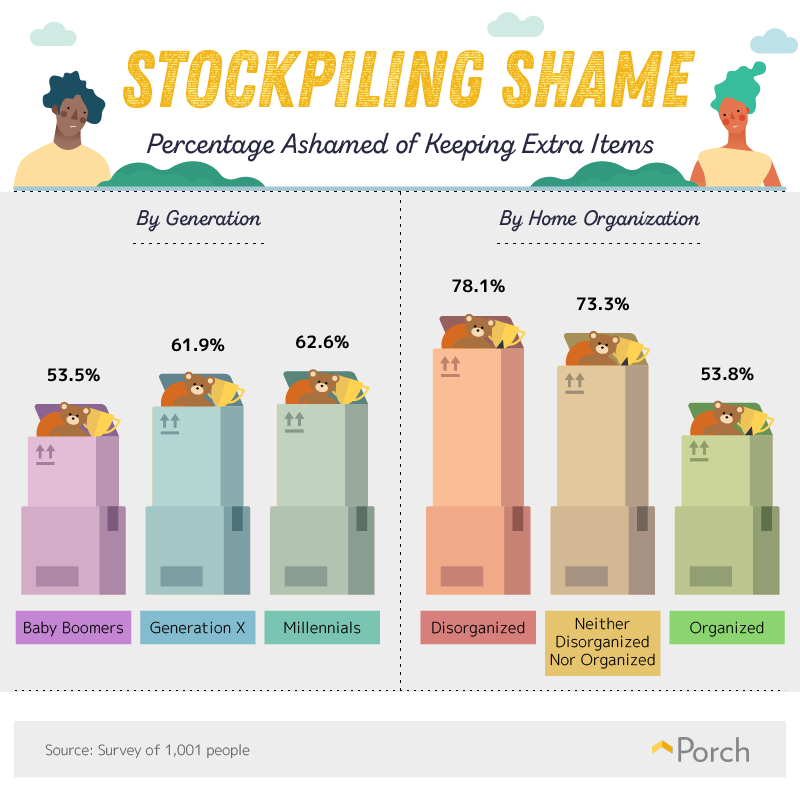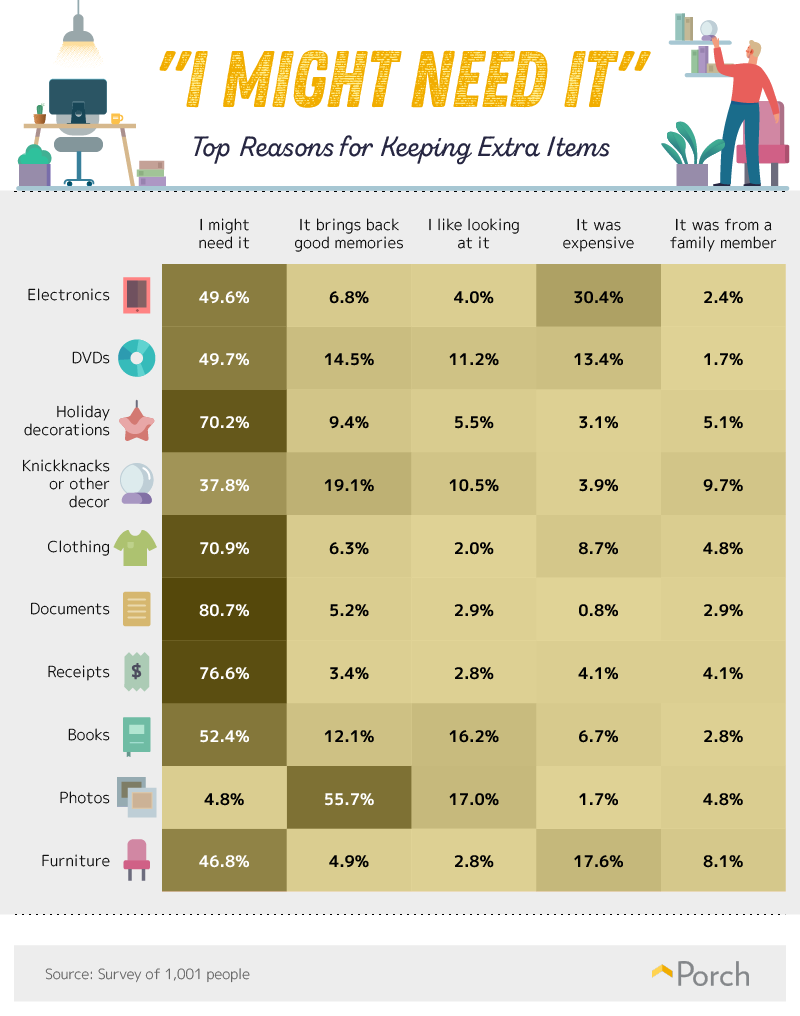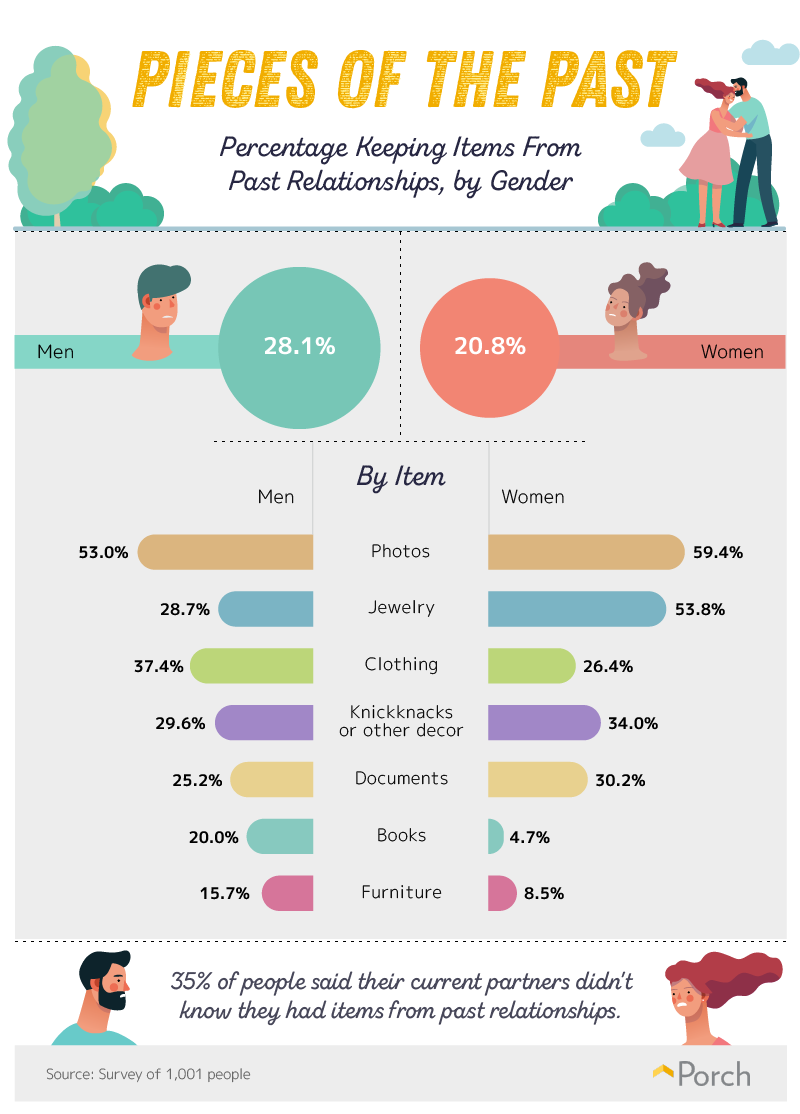
It’s easy to tune in to an episode of “Hoarders” and marvel at the struggle to throw something out. Imagine a junk drawer somehow managing to take over the entire kitchen, or a closet spilling onto the bedroom floor. You might go crazy! While hoarding can be a sign of mental illness, living with less might be harder than it sounds. Experts say minimalism can help save money and make people feel less stressed, but how do you know when it’s time to throw out last year’s receipts or dusty holiday decorations? If you’re even mildly embarrassed by those hidden pockets of personal clutter, you’re probably not alone. To help encourage a healthy dose of cleaning, we polled over 1,000 people about how much space their extra items are taking up in their homes. Read on to see what we learned about keeping the excess.
Feeling flustered
 From the stack of books sitting in your home office to the sneakers propped by the front door, even the most minute details about a house can speak volumes about a person’s personality—from the things they do in their free time to what makes them nervous or uncomfortable. Even a box of cereal on the counter can say something about who we are. When it comes to clutter, however, keeping things squeaky-clean compared to mildly messy might not change the way you feel about your organization skills. Roughly 78 percent of people who perceived themselves as disorganized were ashamed of their mess management. People sitting firmly in the middle, neither disorganized nor organized, felt similar, with around 73 percent citing shame over the state of their home’s condition. While getting things in order may help reduce feelings of embarrassment, it probably won’t cure them completely. Nearly 54 percent of organized people were still ashamed of letting extra items pile up around the house. Some people might even get used to the clutter over time. Compared to almost 63 percent of millennials and 62 percent of Gen Xers, less than 54 percent of baby boomers were ashamed of the potential disarray of their belongings.
From the stack of books sitting in your home office to the sneakers propped by the front door, even the most minute details about a house can speak volumes about a person’s personality—from the things they do in their free time to what makes them nervous or uncomfortable. Even a box of cereal on the counter can say something about who we are. When it comes to clutter, however, keeping things squeaky-clean compared to mildly messy might not change the way you feel about your organization skills. Roughly 78 percent of people who perceived themselves as disorganized were ashamed of their mess management. People sitting firmly in the middle, neither disorganized nor organized, felt similar, with around 73 percent citing shame over the state of their home’s condition. While getting things in order may help reduce feelings of embarrassment, it probably won’t cure them completely. Nearly 54 percent of organized people were still ashamed of letting extra items pile up around the house. Some people might even get used to the clutter over time. Compared to almost 63 percent of millennials and 62 percent of Gen Xers, less than 54 percent of baby boomers were ashamed of the potential disarray of their belongings.
Running out of places to put things
 You don’t need a small downtown apartment or even a dysfunctional kitchen to feel strapped for space. Storage hacks are a favorite DIY resource because most people are bound to feel limited by at least one area of their home, and most of that could be due to clutter. Out of sight might mean out of mind when it comes to stashing extra items. Attics and closets ranked as the most common places for storing additional possessions. On average, respondents estimated roughly 57 percent of their attics and over 56 percent of their closets were utilized to cache clutter. More than half of everyday rooms (including the kitchen and dining room) were also given up to stuff people might not need in the first place. What things are taking up all this square footage in the first place? Clothing was in constant surplus for people of all ages, while documents landed the top spot as the most kept item for baby boomers, followed by holiday decorations for Gen Xers and knickknacks for millennials. If you’ve got extra garments with price tags still on them, you’re not alone, however. Experts suggest we sometimes buy clothing out of impulse or fantasy rather than need or practicality, causing them to pile up and collect dust.
You don’t need a small downtown apartment or even a dysfunctional kitchen to feel strapped for space. Storage hacks are a favorite DIY resource because most people are bound to feel limited by at least one area of their home, and most of that could be due to clutter. Out of sight might mean out of mind when it comes to stashing extra items. Attics and closets ranked as the most common places for storing additional possessions. On average, respondents estimated roughly 57 percent of their attics and over 56 percent of their closets were utilized to cache clutter. More than half of everyday rooms (including the kitchen and dining room) were also given up to stuff people might not need in the first place. What things are taking up all this square footage in the first place? Clothing was in constant surplus for people of all ages, while documents landed the top spot as the most kept item for baby boomers, followed by holiday decorations for Gen Xers and knickknacks for millennials. If you’ve got extra garments with price tags still on them, you’re not alone, however. Experts suggest we sometimes buy clothing out of impulse or fantasy rather than need or practicality, causing them to pile up and collect dust.
Never gonna give you up
 There’s a reason why even thinking about getting rid of extra items can be difficult. Combing through the clutter is a common cleaning task, but research shows it’s a task on which people largely procrastinate. The “Endowment Effect” (a circumstance where people value things they do own over things they don’t already own) could explain why we sometimes feel emotionally attached to inanimate objects. For everything from holiday decorations to clothes and furniture, the biggest reason people were afraid to throw things out was simple: They thought they might eventually need them. It’s hard to dispose of records that could come in handy one day, especially with documents (nearly 81 percent) and receipts (almost 77 percent). Just because you might need those 2007 tax records doesn’t mean you need to keep a shoebox of receipts lying around, though. In fact, most of the financial documents you’re supposed to keep are still acceptable in a digital form. For other possessions, a more emotional need was at play. Nearly 56 percent of respondents kept physical family photos because it brought back good memories, similar to the reason they held onto knickknacks (19 percent), DVDs (15 percent), and books (12 percent). You can’t forget about the price, either. If you spent a lot of money to bring something home, you might feel inclined to hold on to it longer. Over 30 percent of people kept electronics due to their prices.
There’s a reason why even thinking about getting rid of extra items can be difficult. Combing through the clutter is a common cleaning task, but research shows it’s a task on which people largely procrastinate. The “Endowment Effect” (a circumstance where people value things they do own over things they don’t already own) could explain why we sometimes feel emotionally attached to inanimate objects. For everything from holiday decorations to clothes and furniture, the biggest reason people were afraid to throw things out was simple: They thought they might eventually need them. It’s hard to dispose of records that could come in handy one day, especially with documents (nearly 81 percent) and receipts (almost 77 percent). Just because you might need those 2007 tax records doesn’t mean you need to keep a shoebox of receipts lying around, though. In fact, most of the financial documents you’re supposed to keep are still acceptable in a digital form. For other possessions, a more emotional need was at play. Nearly 56 percent of respondents kept physical family photos because it brought back good memories, similar to the reason they held onto knickknacks (19 percent), DVDs (15 percent), and books (12 percent). You can’t forget about the price, either. If you spent a lot of money to bring something home, you might feel inclined to hold on to it longer. Over 30 percent of people kept electronics due to their prices.
Moving on is hard to do
 Throwing things out isn’t always as much about freeing up space as it is about moving on. Relationship experts will tell you there are a handful of things everyone should do after a breakup. Indulging in a new book, picking up a hobby, and erasing old memories from your social media are typically good places to start, but what about all of the stuff they may have left behind? A part of the emotional drain after a breakup could be connected to sorting through (and sometimes returning) possessions. Roughly 21 percent of women and 28 percent of men admitted to holding on to items from past relationships—whether the other person knew it. In most cases, relationship keepsakes amounted to physical photos, with men more likely (37 percent) to keep their ex’s clothes, and a majority of women holding onto jewelry (54 percent). Still, it’s sometimes the everyday things that are the hardest to purge. Thirty-four percent of women and nearly 30 percent of men had knickknacks and other home decor items from past relationships, and only slightly less had personal documents.
Throwing things out isn’t always as much about freeing up space as it is about moving on. Relationship experts will tell you there are a handful of things everyone should do after a breakup. Indulging in a new book, picking up a hobby, and erasing old memories from your social media are typically good places to start, but what about all of the stuff they may have left behind? A part of the emotional drain after a breakup could be connected to sorting through (and sometimes returning) possessions. Roughly 21 percent of women and 28 percent of men admitted to holding on to items from past relationships—whether the other person knew it. In most cases, relationship keepsakes amounted to physical photos, with men more likely (37 percent) to keep their ex’s clothes, and a majority of women holding onto jewelry (54 percent). Still, it’s sometimes the everyday things that are the hardest to purge. Thirty-four percent of women and nearly 30 percent of men had knickknacks and other home decor items from past relationships, and only slightly less had personal documents.
Taking out the trash
 Whether you decide to purge at the first sign of good weather or on a random day off from work, decluttering won’t just make your house look better—it could also help you feel better. Studies suggest cleaning for at least 20 minutes can decrease stress and anxiety by as much as 20 percent, and it could also boost your mood, promote healthier sleep, and keep you physically healthy. While people feel the pressure to purge extra items from their homes, it’s still less likely to get done. Whereas roughly 1 in 3 millennials and Gen Xers and 1 in 4 baby boomers admitted to only rarely cleaning out their stuff, this cleaning exercise was more likely to be occasional than a constant effort for people of all ages. At most, about 15 percent of millennials committed to cleaning out the clutter on a frequent basis.
Whether you decide to purge at the first sign of good weather or on a random day off from work, decluttering won’t just make your house look better—it could also help you feel better. Studies suggest cleaning for at least 20 minutes can decrease stress and anxiety by as much as 20 percent, and it could also boost your mood, promote healthier sleep, and keep you physically healthy. While people feel the pressure to purge extra items from their homes, it’s still less likely to get done. Whereas roughly 1 in 3 millennials and Gen Xers and 1 in 4 baby boomers admitted to only rarely cleaning out their stuff, this cleaning exercise was more likely to be occasional than a constant effort for people of all ages. At most, about 15 percent of millennials committed to cleaning out the clutter on a frequent basis.  Sometimes “out of sight, out of mind” really is the heart of the issue. Eighty-one percent of people felt compelled to clean out their homes after participating in this survey.
Sometimes “out of sight, out of mind” really is the heart of the issue. Eighty-one percent of people felt compelled to clean out their homes after participating in this survey.
Committing to declutter
No matter how much space your great-grandmother’s knickknacks take up in the attic or how tall the pile of books you meant to read last summer may have gotten, procrastination is sometimes a more natural response than we’d like to admit. If you don’t want to spend one more minute thinking about the things that need to get done around the house, we’ve got your back. At Porch, we’re committed to making home improvement as simple as possible, including finding the right person to get the job done. Our free Porch Home Assistant tool is available 24/7 to connect you with one of our Porch Service pros or someone in our network for whatever task is at the top of your to-do list. Don’t let lawn mowing, carpet removal, or paint jobs get you down. Visit us at Porch to get your next project started today.
Methodology and Limitations
To gather the data represented in the above study, Amazon’s Mechanical Turk service was used to survey 1,001 people about their home organization levels and how it made them feel. Of these respondents, 544 identified as women, 456 identified as men, and one chose to identify as neither. The study included 114 baby boomers, 291 Gen Xers, 578 millennials, and 18 from other generations. The data in this study rely on self-reporting, so any responses could be subject to exaggeration, telescoping, or a number of other related issues. In this study, certain steps were taken to ensure that respondents were paying attention and giving as accurate responses as possible, such as presenting respondents with attention checks to ensure they were paying attention and not answering randomly.
Sources
- https://www.salon.com/2016/01/23/stop_watching_hoarders_our_lurid_reality_tv_obsession_with_mental_illness_has_crossed_a_line/
- https://www.moneyunder30.com/minimalist-living
- https://www.rd.com/home/improvement/what-house-says-about-you/
- https://www.thespruce.com/storage-ideas-for-your-entire-home-4138609
- https://www.nbcnews.com/business/consumer/why-do-we-keep-buying-things-we-never-wear-n682516
- https://www.bustle.com/p/why-is-it-so-hard-to-throw-things-away-science-can-explain-your-aversion-to-decluttering-video-27591
- https://www.nytimes.com/2018/02/23/your-money/financial-documents-you-should-keep.html
- https://www.huffingtonpost.com/kristin-davin-psyd/5-ways-to-move-on-after-a_b_9097696.html
- https://www.rd.com/home/cleaning-organizing/spring-cleaning-benefits/
- https://www.verywellmind.com/the-psychology-of-procrastination-2795944
Fair Use Statement
Guilty of letting an unruly junk drawer (or two) go unaddressed? We won’t judge. Instead, feel free to pass along the results of this study and all related images to your own readers for any noncommercial use. In return, just make sure to include a link back to this page so that they can see the full scope of our findings for themselves.
